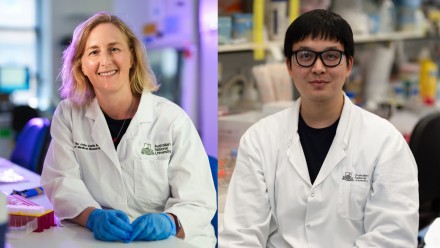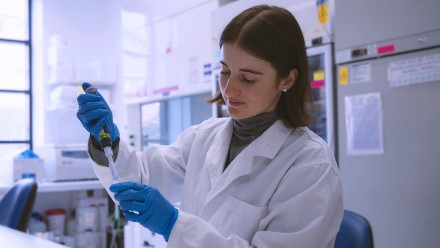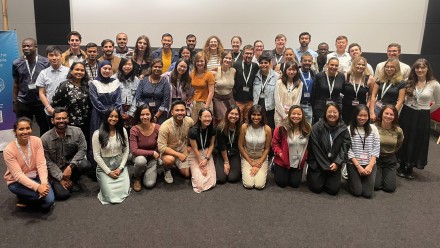The Quinn Group - Brain Cancer Discovery
The >1800 patients diagnosed with primary brain cancer in Australia annually are faced with a dire prognosis: a 20% chance of survival beyond 5 years. Alarmingly, no new therapies have entered the brain cancer clinic in 35 years and, thus, patient outcomes have not improved in more than 3 decades. A major impediment to improving primary brain cancer (glioma) treatment is our poor understanding of normal brain development, the critical first step in unravelling the complex molecular genetics of glioma. For this, we require sophisticated genetic models as glioma is not one disease, but comprises many sub-categories characterised by a combination of unique mutations and molecular changes.
As glioma is predicted to be driven by tumour stem cells, a core research strategy employed by the Brain Cancer Discovery Group is to use sophisticated Drosophila (vinegar fly) genetic models to determine how genes mutated in glioma alter neural stem and progenitor cell (NSPC) fate. Very excitingly, novel tumour suppressor genes identified in human glioma drive NSPC overproliferation, a hallmark of cancer, in the fly brain. Thus, our genetic models are providing insight into NSPC dysfunction driven by glioma mutations and, critically, enabling dissection of the molecular genetic signatures of specific brain cancer sub-types.
The development of efficacious brain cancer therapies has been severely hampered by the inherent disconnect between fundamental research and the clinic. Towards closing this gap, we have also established the Canberra Brain Cancer Collaborative (CBCC). This interdisciplinary collaborative connects drug discovery research at Australian National University (ANU) with clinical endeavours at The Canberra Hospital (TCH) oncology, neurosurgery, radiation oncology, and neuro-pathology units.
Moreover, through the ACT Brain Cancer Biobank (ABCB), the Canberra node of Brain Cancer Biobanking Australia (BCBA), we are generating the diverse glioma genotypes necessary for drug discovery research. Critically, our pipelines involve whole genome and transcriptome sequencing of primary glioma stem cells from patients, providing the deep molecular classification for brain tumours; the integration with imaging, histopathological, and patient data is essential to develop robust pre-clinical models for drug discovery. To identify drugs targeting brain cancer sub-types, we use human brain organoid “mini-brain” models to recreate the heterogenous cellular composition of brain tumours. These next-generation, three-dimensional cell systems are enabling us to model progression of specific tumour sub-types and, ultimately, identify new therapies capable of killing cancer cells while leaving the patient’s healthy neural cells intact. Thus, we will identify new therapeutic candidates that can be fast-tracked to the clinic to improve patient outcomes.
If you wish to support our Brain Cancer Research Program please visit the Australian Brain Cancer Foundation website.
Enquiries are welcome from potential Honours or PhD students. A variety of projects are available within all of the areas of research undertaken by this Group. Please contact us.
Leader
Researchers
Technicians
Students
Collaborators
External members
- Dr David Levens
- Dr Ganes Pranavan
- Dr Peter Mews
- Dr Mitali Fadia
- Dr Hari Bandi
- Professor Lee Wong
Selected publications
- O. Zaytseva, N.C. Mitchell, D. Muckle, C. Delandre, Z. Nie, J.K. Werner, J.T. Lis, E. Eyras, R.D. Hannan, D.L. Levens, O.J. Marshall, L.M. Quinn. Psi promotes Drosophila wing growth via direct transcriptional activation of cell cycle targets and repression of growth inhibitors. Development. 150 (2023). https://doi.org/10.1242/dev.201563. (5YIF: 7.799, accepted Jan 2023)
- Olga Zaytseva, Naomi Mitchell, Linna Guo, et al., Leonie Quinn. Transcriptional repression of Myc underlies AGO1's tumour suppressor function. Development. 2020. 147: dev190231 doi: 10.1242/dev.190231. June issue “Research Highlight" and “People Behind the Papers” feature interview (5YIF: 7.799)
- Nick Lim#, Belal Shohayeb#, Olga Zaytseva, Naomi Mitchell, Marie Bogoyevitch, *Dominc Ng, and *Leonie Quinn, (# co-first, *co-senior). Glial-specific functions of microcephaly protein WDR62, and interaction with the mitotic kinase AURKA, are essential for Drosophila brain growth. Stem Cell Reports 2017 v9 (1), p32–41 (IF 7.338).
- Linna Guo, Olga Zaysteva, Zuqin Nie, Naomi C Mitchell, Jue Er Amanda Lee, Thomas Ware, Linda Parsons, Rodney Luwor, Gretchen Poortinga, Ross D Hannan, David L Levens, Leonie Quinn. Defining the essential function of FBP/KSRP proteins: Drosophila Psi interacts with the Mediator Complex to modulate MYC transcription and tissue growth. Nucleic Acids Research 2016 doi.org/10.1093/nar/gkw461 (IF 9.12)
- Nicole Dominado#, John E. La Marca#, Nicole A. Siddall, James Heaney, Mai Tran, Yu Cai, Fengwei Yu†, Hongyan Wang, W. Gregory Somers, *Leonie Quinn and *Gary Hime (# co-first author *co-senior and corresponding authors). Rbf regulates Drosophila spermatogenesis via control of somatic stem and progenitor cell fate in the larval testis. Stem Cell Reports 2016 7(6), 1152–1163. http://doi.org/10.1016/j.stemcr.2016.11.007 (IF 7.338).
- Naomi Mitchell, Elissaveta Tchoubrieva, Arjun Chahal, Simone Woods, Amanda Lee, Jane Lin, Linda Parsons, Gretchen Poortinga, Katherine Hannan, Richard Pearson, Ross Hannan and Leonie Quinn. Signalling to ribosomal RNA synthesis: MYC-driven rDNA transcription requires S6 Kinase. Cellular Signalling 2015 doi: 10.1016/j.cellsig.2015.07.018.
- Jue Er Amanda Lee, Naomi Mitchell, Olga Zaytseva, Arjun Chahal, Peter Mendis, Linda Parsons, Gretchen Poortinga, David Levens, Ross Hannan, and Leonie Quinn. Hfp-dependent transcriptional repression of dMYC is fundamental to tissue overgrowth in Drosophila XPB models. Nature Communications 2015; doi:10.1038/ncomms8404. [IF=10.742]
- Olga Zaytseva, Nora Tenis, Naomi Mitchell, Shin-ichiro Kanno, Akira Yasui, Jörg Heierhorst and Leonie Quinn. ASCIZ regulates development and mitosis in Drosophila as a conserved regulator of Cutup/dynein light chain. Genetics 2014; 196 (2): 443–53. doi:10.1534/genetics.113.159541.
- Poortinga, G., L. M. Quinn, and R. D. Hannan. 2014. Targeting RNA Polymerase I to Treat MYC-Driven Cancer. Oncogene 2014; (10) 1038/onc.2014.13.
- Jane Lin, Naomi Mitchell, Elly Tchoubrieva, Mary Stewart, Steven Marygold, Richard Pearson, *Leonie Quinn and *Ross Hannan. Drosophila Ribosomal Protein Mutants Control Tissue Growth Non-Autonomously via Effects on the Prothoracic Gland and Ecdysone. PloS Genetics 2011; 7 (12) e1002408 (*co-senior and corresponding authors)
- Naomi Mitchell, Timothy Johanson, Nicola Cranna, Amanda Lee, Helena Richardson, Ross Hannan and Leonie Quinn. Hfp inhibits Drosophila myc transcription and cell growth in a TFIIH/Hay-dependent manner. Development 2010; 137, 2875-2884.
- Adrian Monk, Nicole Siddall, Talila Volk, Barbara Fraser, Leonie Quinn, Eileen McLaughlin and Gary Hime. How is required for stem cell maintenance in the Drosophila testis and for the onset of transit amplifying divisions. Cell Stem Cell 2010; 6(4): 348-60.
- Naomi Mitchell, Nicola Cranna, Helena Richardson and Leonie Quinn. The Ecdysone- inducible zinc finger transcription factor, Crol regulates wg transcription and cell cycle progression in Drosophila. Development 2008; (featured on the front cover). 135(16): 2707-16.









